the place
The Ecodharma Centre is based in a remote mountain valley in the Sierra de Carreu of the Catalan Pyrenees. Four kilometres from the small village of Abella de la Conca, several old farmhouses in various states of renovation together with some low-impact structures provide shelter within a mountainous landscape that is both wild and intimate. Over 50 hectares of mixed woodland, pasture, scrub, and limestone outcrops sit within an area largely uninhabited by humans. The valley backs onto the savage ravines, forest and open moorlands of the Boumort National Nature Reserve.
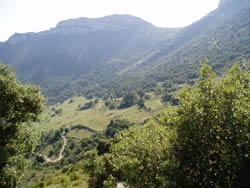 The sheer limestone cliffs of the Carreu ridge to the north and only a small breach in the Caranima ridge to the south (allowing only dirt track access), create a valley with natural geographical seclusion and a sense of remoteness. The natural beauty helps us to stay rooted in the biological while letting our imaginations soar in the open sky above. The wild and remote quality of the place heals and antidotes alienation from the natural world which urban lifestyles press upon us. The lifestyle here is quite simple.
The sheer limestone cliffs of the Carreu ridge to the north and only a small breach in the Caranima ridge to the south (allowing only dirt track access), create a valley with natural geographical seclusion and a sense of remoteness. The natural beauty helps us to stay rooted in the biological while letting our imaginations soar in the open sky above. The wild and remote quality of the place heals and antidotes alienation from the natural world which urban lifestyles press upon us. The lifestyle here is quite simple.
Querencia: “a deep, quiet sense of inner well-being that comes from knowing a particular place of the earth, its diurnal and seasonal patterns, its fruits and scents, its history and its part in your history… where, whenever you return to it, your soul releases an inner sigh of recognition and relaxation.” - Kirkpatrick Sale, Dwellers in the Land
The place is shared by many non-human inhabitants. Eagles, vultures, and red-tailed kites circle above, describing the thermal currents with their soaring spiral movements. Wild pigs forage in the woods at night. The deer and isards stand and stare, before effortlessly disappearing behind a wooded ridge. The rocks and the trees tolerate our presence. Life here naturally evokes a kind of deep ecological sensibility and simple delight in the elements.
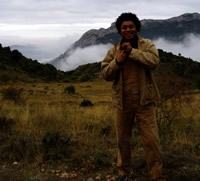 The valley sits right on the cusp of the transition from Mediterranean to sub-alpine climate zones. Each season offers its own magic in this powerfully elemental place.
The valley sits right on the cusp of the transition from Mediterranean to sub-alpine climate zones. Each season offers its own magic in this powerfully elemental place.
The winter months are beautifully marked by anti-cyclonic weather systems sitting around us from December to February – bringing deep blue, luminous skies and a warm winter sun. Even when the weather is poor, the thermal inversions often mean that we wake up above the clouds. Surrounding peaks rise up out of a sea of clouds, while the open sky remains overhead. While the world below is shrouded in freezing winter mist, here we can still enjoy the winter sun. Although winter days can be warm, the nights can be profoundly cold. A good stock of firewood and efficient stoves ensure enough comfort! It usually snows a few times each year. But being on the south face of the mountain the sun soon melts it off and it rarely lasts on the ground here for more than a couple of days. Nevertheless, a short walk to the north side of the ridge reveals a truly alpine winter landscape, where you can sometimes play in drifts of snow up to your waist. During February the weather usually turns creating the hardest month in terms of cold and grey days.
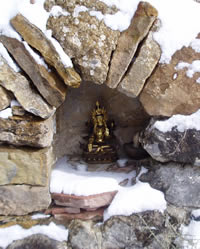 Spring brings a cycle of flowers and fragrances, as wild herbs and fruit trees blossom in succession. The honey bees begin their work and migratory birds begin to make themselves known. It is a beautiful season when the vegetable gardens begin to bring forth salad vegetables and the fresh garlic comes just in time to replenish the stock of bulbs usually just running out from the previous summer harvest. The streams flow well and the river down below cascades full of the snow melt waters and spring shower rain, making the first swim of the year irresistible – even if the water is still on the cold side.
Spring brings a cycle of flowers and fragrances, as wild herbs and fruit trees blossom in succession. The honey bees begin their work and migratory birds begin to make themselves known. It is a beautiful season when the vegetable gardens begin to bring forth salad vegetables and the fresh garlic comes just in time to replenish the stock of bulbs usually just running out from the previous summer harvest. The streams flow well and the river down below cascades full of the snow melt waters and spring shower rain, making the first swim of the year irresistible – even if the water is still on the cold side.
Summer comes with flowering thyme, and ripening cherries and plums. The gardens begin to overflow with offerings, the sun gets stronger and by the end of July long walks in the middle of the day start to be unwise. But of course the long days, early morning sun and extended evening light make up for that. And being up high there is almost always a breeze in the shade of the trees, offering respite on even the hottest days. Of course, the pools of the river below have a strong allure. With the heat of August come the most powerful storms of the year, which tend to burst out in the late afternoon perhaps a couple of times a week during that month. The earth can literally tremble as lightning and thunder crash through the valley, and we find ourselves right in the heart of the storm. Sudden downpours can turn every path and track into a turbulent torrent and we see how all the mountains of the world are slowly marching towards the sea!
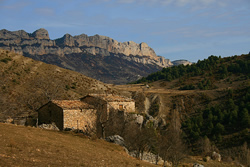 Autumn arrives slowly and then seems to stay forever. Everything seems to be ripening too fast and conserves and jarred vegetables need to be prepared. We hope for gentle rains to saturate the ground before the dry winter months arrive. The cherry trees blaze red and orange leaves, as the turning leaves of the white poplars and deciduous oaks punctuate the woodland of evergreen oak and pine. The dog roses become a blaze of rosehips which we gather by the basket full to make excellent tea. The deer begin to sound their strange bellowing on the ridge above and the wild pigs forage the acorns falling throughout the woods.
Autumn arrives slowly and then seems to stay forever. Everything seems to be ripening too fast and conserves and jarred vegetables need to be prepared. We hope for gentle rains to saturate the ground before the dry winter months arrive. The cherry trees blaze red and orange leaves, as the turning leaves of the white poplars and deciduous oaks punctuate the woodland of evergreen oak and pine. The dog roses become a blaze of rosehips which we gather by the basket full to make excellent tea. The deer begin to sound their strange bellowing on the ridge above and the wild pigs forage the acorns falling throughout the woods.
We are trying to implement sustainable living systems in our approach, learning to apply permaculture techniques and principles where we can. Almost all of our power here is generated by renewable sources. We have solar energy systems at a couple of the houses and other small living structures (like the solitary retreat cabin) have small solar systems too. Storerooms traditionally built into the hillside seem adequate for keeping foodstuffs cool. Solar water heating systems are usually sufficient for our needs if we respect our water as a resource that is not unlimited! In the winter living spaces are heated with wood-burning stoves. We have a general policy of cutting wood sustainably. We have begun a study for the sustainable management of the woodland and have planted a forest garden with over 150 fruit and nut trees. We also aim to cultivate the land in order to provide a large part of the requirements of the community here – working gradually towards more self-reliance in food and fuel.
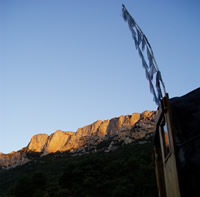 We are developing things here in a slow and organic fashion, keen not to do so too fast. Finding the balance between convenience and simple living is not easy and there are no set answers. Every added convenience can also be the loss of an activity that can trace connection to the earth. We want this place to grow out of needs, not an overarching plan toward greater efficiency for its own sake. It feels very healthy to have a reasonable amount of time dedicated to simple tasks which are essential for life. It connects us to the land, to the place, and to the basic rhythms of life.
We are developing things here in a slow and organic fashion, keen not to do so too fast. Finding the balance between convenience and simple living is not easy and there are no set answers. Every added convenience can also be the loss of an activity that can trace connection to the earth. We want this place to grow out of needs, not an overarching plan toward greater efficiency for its own sake. It feels very healthy to have a reasonable amount of time dedicated to simple tasks which are essential for life. It connects us to the land, to the place, and to the basic rhythms of life.
